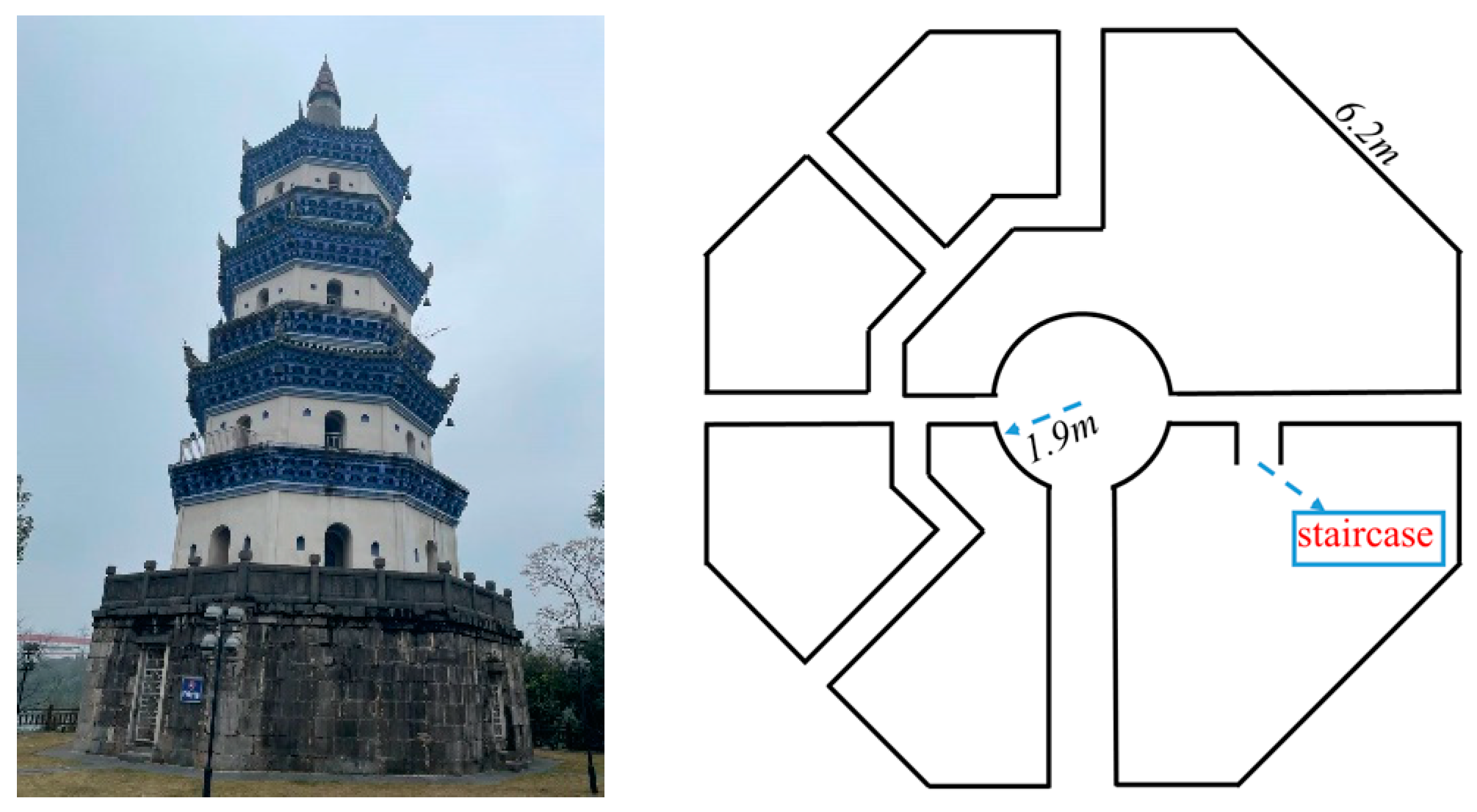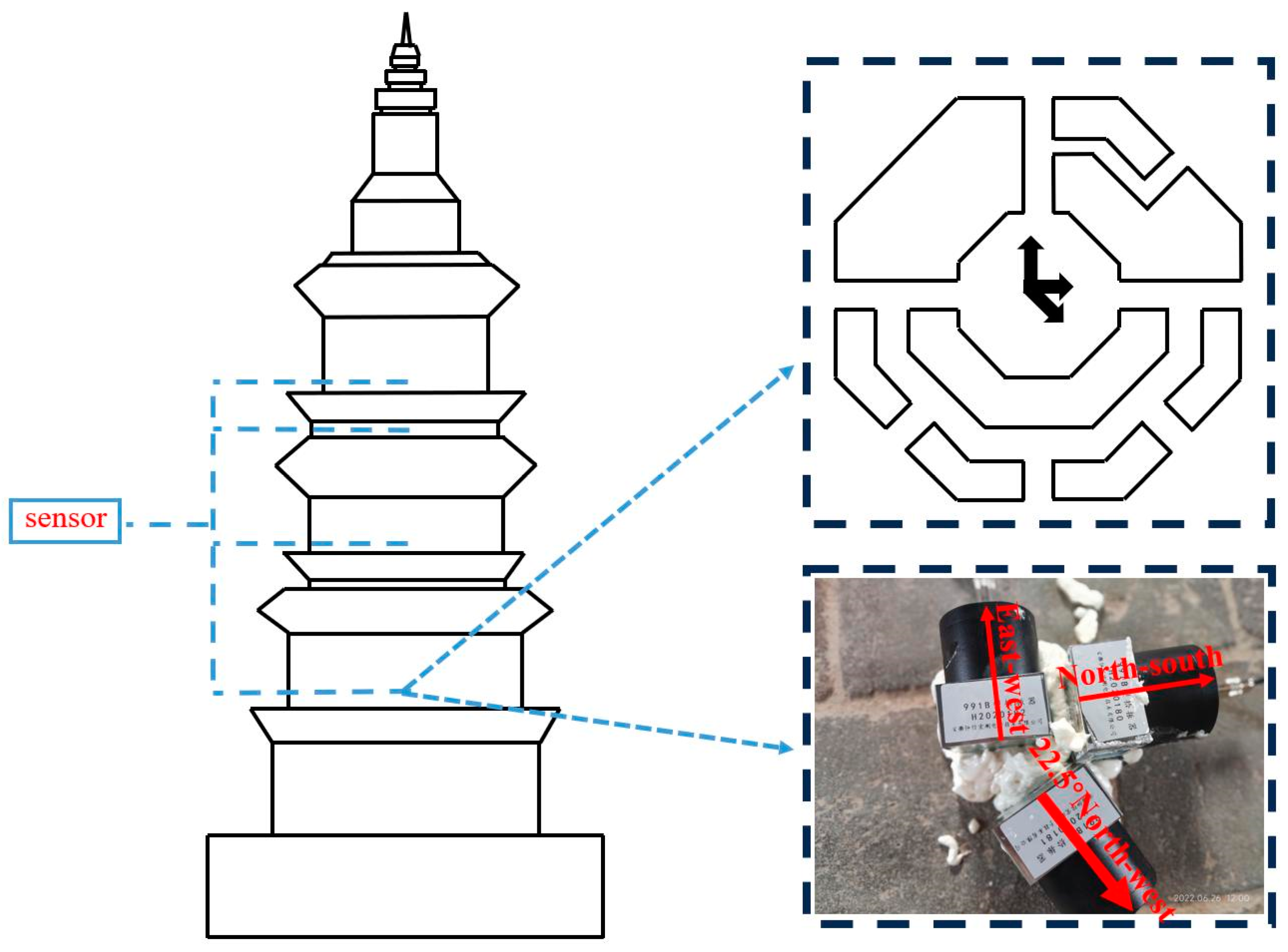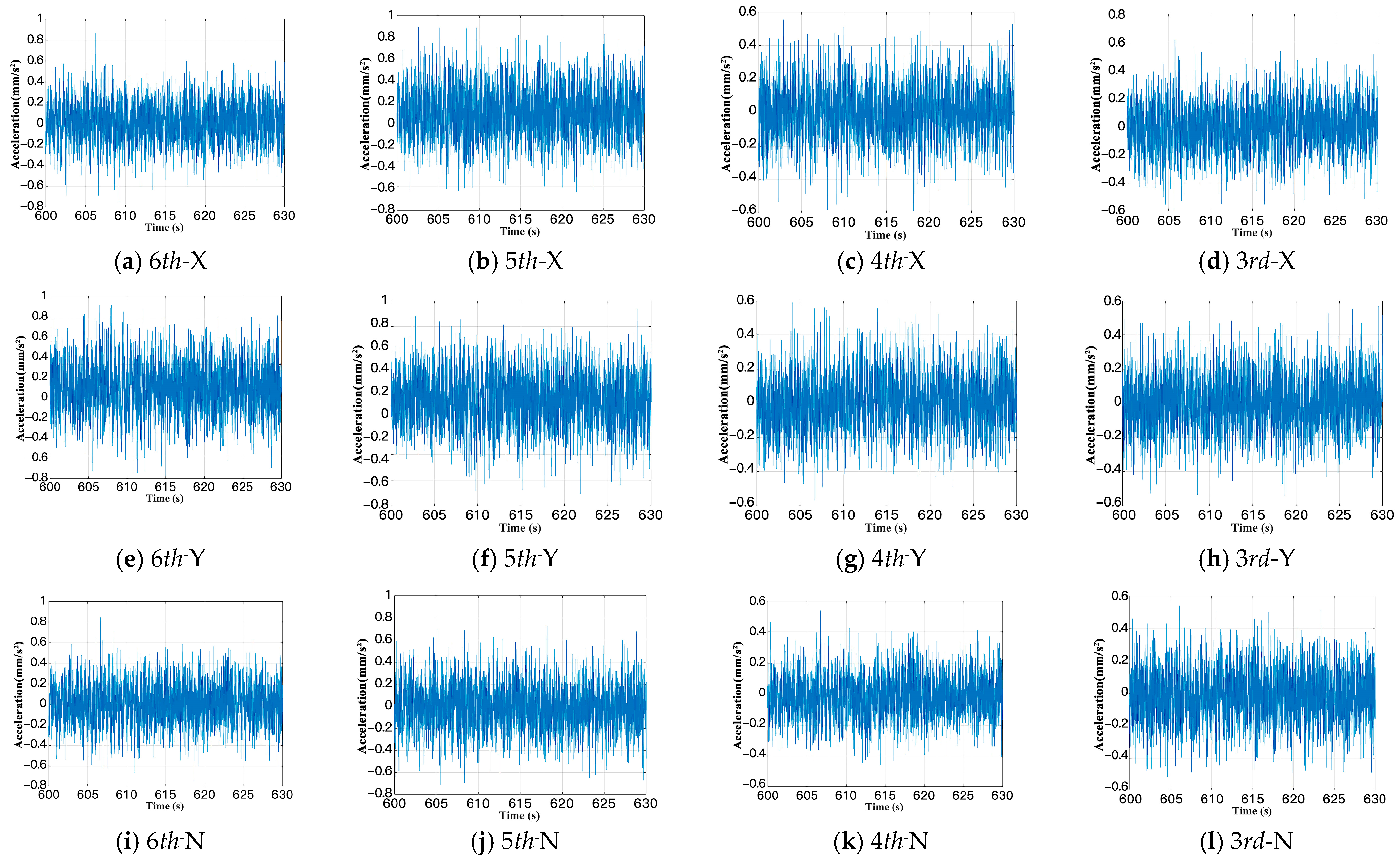In Situ Testing and FEM Analysis of Dynamic Characteristics of a Masonry Pagoda under Natural Excitation
Abstract
:1. Introduction
2. Structure Overview
3. Measurement of Dynamic Characteristics
3.1. Sensor Arrangement
3.2. Time History Analysis
3.3. Acceleration Self Power Spectral Density Function
4. Modal Identification of Huilong Pagoda
4.1. SSI Method
4.2. NExT-ERA Method
4.3. Natural Frequency Comparison
4.4. Damping Ratio Comparison
5. Finite Element Modal Analysis
5.1. Finite Element Modal
5.2. Modal Analysis Results
6. Conclusions
- The maximum relative error between the results obtained by the SSI method and the NExT-ERA method in determining the natural frequency of the Huilong Pagoda is 3.56%, which verifies the accuracy of the NExT-ERA method in determining the dynamic characteristic parameters of the masonry pagoda.
- Comparing the damping results obtained by the two methods of clearance, it was determined that the overall structural damping of the ancient pagoda is between 0.21% and 2.89%, indicating a low level of damping.
- A macroscopic numerical model of the Huilong Pagoda was established, and the finite element analysis results were compared with the natural frequency identified by the NExT-ERA method. The results showed that the calculation results were in good agreement with the identification results, with a maximum relative error of 8.54% in the Y-direction. The model exhibited structural symmetry and uniform stress performance.
Author Contributions
Funding
Data Availability Statement
Conflicts of Interest
References
- Liang, S. A Pictorial History of Chinese Architecture; SDX Joint Publishing Company: Beijing, China, 2023. [Google Scholar]
- Preciado, A. Seismic vulnerability and failure modes simulation of ancient masonry towers by validated virtual finite element models. Eng. Fail. Anal. 2015, 57, 72–87. [Google Scholar] [CrossRef]
- Wu, X.Q.; Lu, J.L.; Wang, Z.S.; Yang, W.; Qiao, N. Dynamic characteristics and seismic response analysis of the bottle-shaped masonry ancient pagoda. Structures 2022, 44, 1648–1659. [Google Scholar] [CrossRef]
- Bartoli, G.; Betti, M.; Giordano, S. In situ static and dynamic investigations on the “Torre Grossa” masonry tower. Eng. Struct. 2013, 52, 718–733. [Google Scholar] [CrossRef]
- Ashayeri, I.; Biglari, M.; Formisano, A.; D’Amato, M. Ambient vibration testing and empirical relation for natural period of historical mosques. Case study of eight mosques in Kermanshah, Iran. Constr. Build. Mater. 2021, 289, 123191. [Google Scholar] [CrossRef]
- Tassello, A. Numerical Model and Seismic Structural Analysis of the Lamberti Tower. Master’s Thesis, Universidade do Minho, Braga, Portugal, 2013. [Google Scholar]
- Peña, F.; Lourenço, P.B.; Mendes, N.; Oliveira, D.V. Numerical models for the seismic assessment of an old masonry tower. Eng. Struct. 2010, 32, 1466–1478. [Google Scholar] [CrossRef]
- Ramos, L.F.; Casarin, F.; Algeri, C.; Modena, C. Investigations techniques carried out on the Qutb Minar, New Delhi, India. In Structural Analysis of Historical Constructions; Macmillan India Ltd.: Noida, India, 2006. [Google Scholar]
- Cabboi, A.; Gentile, C.; Saisi, A. From continuous vibration monitoring to FEM-based damage assessment: Application on a stone-masonry tower. Constr. Build. Mater. 2017, 156, 252–265. [Google Scholar] [CrossRef]
- Altunişik, A.C.; Adanur, S.; Genç, A.F.; Günaydin, M.; Okur, F.Y. Non-destructive testing of an ancient Masonry Bastion. J. Cult. Herit. 2016, 22, 1049–1054. [Google Scholar] [CrossRef]
- Nistico, N.; Gambarelli, S.; Fascetti, A.; Quaranta, G. Experimental Dynamic Testing and Numerical Modeling of Historical Belfry. Int. J. Archit. Herit. 2016, 10, 476–485. [Google Scholar] [CrossRef]
- Wan, L.; Hong, M.; Xu, J.C. Identification of modal parameters for model of a ship hull girder under ambient excitation based on NExT/ERA method. J. Ship Mech. 2013, 17, 774–784. [Google Scholar]
- Xu, Y.; Brownjohn, J.M.W.; Hester, D. Enhanced sparse component analysis for operational modal identification of real-life bridge structures. Mech. Syst. Signal Process. 2019, 116, 585–605. [Google Scholar] [CrossRef]
- Abdelbarr, M.H.; Massari, A.; Kohler, M.D.; Masri, S.F. Decomposition Approach for Damage Detection, Localization, and Quantification for a 52-Story Building in Downtown Los Angeles. J. Eng. Mech. 2020, 146, 04020089. [Google Scholar] [CrossRef]
- Guo, Z.W.; Shi, H.B.; Gong, H.F.; Ma, T.; Huang, X. Statistical characteristics of modal damping of long-span suspension bridge at different wind speeds. J. Vib. Control 2024, 30, 487–501. [Google Scholar] [CrossRef]
- Hu, J.X.; Li, Z.N.; Wang, C.Q.; Duan, X.N.; Shen, Y.J. Modal parameter identification of a high-rise building in Haikou city during typhoons. J. Build. Struct. 2020, 41, 71–82. [Google Scholar] [CrossRef]
- James, G.H.I.; Carne, T.G.; Lauffer, J.P. The Natural Excitation Technique (NEXT) for Modal Parameter Extraction from Operating Wind Turbines. Nasa Sti/Recon Tech. Rep. N 1993, 93, 260–277. [Google Scholar]
- Juang, J.N.; Pappa, R.S. An eigensystem realization algorithm for modal parameter identification and model reduction. J. Guid. Control. Dyn. 1985, 8, 620–627. [Google Scholar] [CrossRef]
- Chang, M.; Pakzad, S.N.; Leonard, R. Modal Identification Using SMIT. Top. Dyn. Civ. Struct. 2012, 1, 221–228. [Google Scholar] [CrossRef] [PubMed]
- Raghavendrachar, M.; Aktan, A.E. Flexibility by Multireference Impact Testing for Bridge Diagnostics. J. Struct. Eng. 1992, 118, 2186–2203. [Google Scholar] [CrossRef]
- Chun, Q.; Yang, H.B.; Meng, Z.; Han, Y. Research on the architectural form and structural performance of the brick-vault hall of Yongzuo Temple. Sci. Conserv. Archaeol. 2019, 31, 85–91. [Google Scholar] [CrossRef]
- Wang, D. The Dynamic Impact on the Structure of the Staircase and the Countermeasure Research. Master’s Thesis, Lanzhou Jiaotong University, Lanzhou, China, 2014. [Google Scholar]














| First Order | Second Order | Third Order | |
|---|---|---|---|
| X-direction | 2.009 | 6.724 | 21.360 |
| Damping (%) | 2.13 | 0.62 | 0.15 |
| Y-direction | 1.992 | 7.440 | 21.360 |
| Damping (%) | 3.06 | 0.79 | 0.31 |
| Order | SSI | NExT-ERA | Relative Error (%) | |
|---|---|---|---|---|
| X-direction | First order | 2.009 | 1.937 | 3.56 |
| Second order | 6.724 | 6.802 | 1.16 | |
| Third order | 21.360 | 21.361 | 0.01 | |
| Y-direction | First order | 1.992 | 1.935 | 2.86 |
| Second order | 7.440 | 7.439 | 0.01 | |
| Third order | 21.360 | 21.398 | 0.18 |
| Order | SSI | NExT-ERA | Average Value (%) | |
|---|---|---|---|---|
| X-direction | First order | 2.13% | 2.22% | 2.18 |
| Second order | 0.62% | 0.71% | 0.67 | |
| Third order | 0.15% | 0.14% | 0.15 | |
| Y-direction | First order | 3.06% | 2.72% | 2.89 |
| Second order | 0.79% | 0.73% | 0.76 | |
| Third order | 2.13% | 2.22% | 2.18 |
| Density (kg/m3) | Young’s Modulus (GPa) | Poisson’s Ratio | |
|---|---|---|---|
| Blue brick | 1800 | 1.8 | 0.15 |
| Bluestone | 2693.8 | 80 | 0.25 |
| Granite | 2660 | 66 | 0.15 |
| NExT-ERA | Analysis Result | Relative Error (%) | |
|---|---|---|---|
| X-direction | 1.937 | 2.042 | 5.14 |
| 6.802 | 6.827 | 0.37 | |
| 21.361 | 21.476 | 0.54 | |
| Y-direction | 1.935 | 2.083 | 7.11 |
| 7.439 | 6.854 | 8.54 | |
| 21.398 | 21.303 | 0.45 |
Disclaimer/Publisher’s Note: The statements, opinions and data contained in all publications are solely those of the individual author(s) and contributor(s) and not of MDPI and/or the editor(s). MDPI and/or the editor(s) disclaim responsibility for any injury to people or property resulting from any ideas, methods, instructions or products referred to in the content. |
© 2024 by the authors. Licensee MDPI, Basel, Switzerland. This article is an open access article distributed under the terms and conditions of the Creative Commons Attribution (CC BY) license (https://creativecommons.org/licenses/by/4.0/).
Share and Cite
Hu, J.; Zhou, J.; Wang, S.; Sun, M.; Chen, H.; Li, X. In Situ Testing and FEM Analysis of Dynamic Characteristics of a Masonry Pagoda under Natural Excitation. Buildings 2024, 14, 1700. https://doi.org/10.3390/buildings14061700
Hu J, Zhou J, Wang S, Sun M, Chen H, Li X. In Situ Testing and FEM Analysis of Dynamic Characteristics of a Masonry Pagoda under Natural Excitation. Buildings. 2024; 14(6):1700. https://doi.org/10.3390/buildings14061700
Chicago/Turabian StyleHu, Jiaxing, Ji Zhou, Shilong Wang, Ming Sun, Hui Chen, and Xiaowu Li. 2024. "In Situ Testing and FEM Analysis of Dynamic Characteristics of a Masonry Pagoda under Natural Excitation" Buildings 14, no. 6: 1700. https://doi.org/10.3390/buildings14061700





